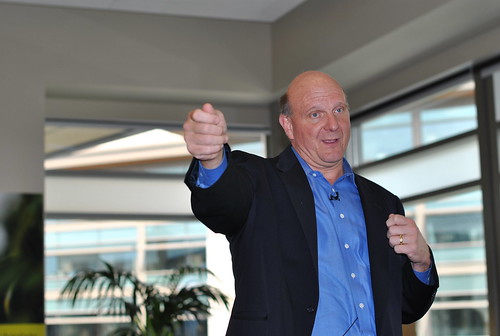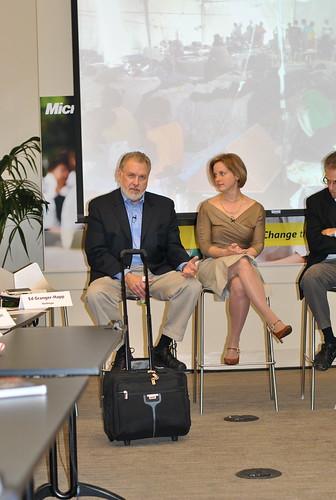
Earlier this month, I had an opportunity to attend Microsoft’s “Accelerator Summit,” a day of conversation with Microsoft employees, partners, academics, journalists, and bloggers about their corporate citizenship program. Their strategy focuses on technology and partnerships that can accelerate systemic on the ground social change and economic issues.
The Accelerator Summit included interactive sessions show casing their programs in these areas: workforce development, employee giving, environment, online safety, and the role of technology in the non-profit community. While I was very familiar with impressive partnership between Microsoft and TechSoup Global, I had no idea of the overall scale of their Corporate Citizenship program which was ranked 14 on a list of the 100 best corporate citizens by Corporate Responsibility magazine, which evaluated performance on a range of issues such as environment, climate change, employee relations, human rights and philanthropy.
Chatting with David Connor, we both had the same reaction – who knew? Here’s a few gems from outside of my sweet spot of nonprofit technology:
- PhotoDNA is an team effort between Microsoft researchers and Dartmouth College computer science professor Hany Farid to create a way to identify and remove images of child pornography from search engines, based on matching their digital fingerprints provided by law enforcement agencies.
- Microsoft researchers are collaborating with the academic community on environmental problems, such as aggregation and visualization of complex scientific data from many sources. Take for example deploying 200 sensors throughout the Brazilian rainforest to measure and visualize the effects of climate change. Or the Web site Microsoft Hohm that lets people calculate their energy footprint and get tips on conservation.
- Elevate America a workforce development program, that provides one million vouchers for Microsoft e-learning courses and select certification exams at no cost to recipients. The program works in partnership with states across the country.

Leveraging Networks with Partnerships
After lunch, Steve Ballmer, Microsoft’s CEO gave his perspective on the company’s philanthropy and corporate citizen activities and answered questions. One theme he touched on that resonated throughout the day is how Microsoft is working with networks and partners to leverage it’s financial, technical, and social change commitment. In a follow up blog post by Pamela Passman, Senior Vice President of Global Affairs, who was our host for the event, she amplifies this point. “Our citizenship work is grounded in the power of our people, our products and our partners to address social and economic opportunity. This enables us to have impact, scale and sustainability. “
Akhtar Badshah, Senior Director, Global Community Affairs at Microsoft, facilitated a discussion on the transformative role of technology in enabling NGOs. The panel included two winners of the NTC/NTEN Life Time Achievement Award – NetHope’s Ed Granger-Happ and TechSoup Global’s Daniel Ben-Horin. Microsoft’s technology capacity work in the nonprofit technology sector includes partnerships with Tech Soup Global, NetHope in disaster relief as well as others. Microsoft has heavily invested in networks and there are probably a lot of wisdom about network effectiveness there.

Even though I have worked closely with several TechSoup Global partners (I keynoted a conference for their partner in Australia and taught workshops for their partner in India), I learned some new insights:
- It’s not about the software or providing access to the tools. TechSoup works with 32 partners throughout the world to provide Microsoft products at a discount. But as Daniel Ben-Horin said, “Our theory of change states that software products are necessary, but not sufficient for empowerment of social change organizations. We embed the product donation with a connection to the community and capacity building.”
- Through its network of 32 partners (and growing), they have been able to reach and work with over 100,000 nonprofits on every continent of the world.
Ed Granger-Happ and Claire Bonilla, Senior Director of Disaster Response at Microsoft, talked about their efforts in building IT infrastructure and data sharing in Haiti after the initial relief efforts and how they are building in a “Layer of resiliency” As Granger-Happ said, ““The question is how do we turn the people NGOs work with from the group being serviced to serving?” The shift is from victims to survivors to sustaining entrepreneurs.
Ben Horin noted that TechSoup Global did not have a partner in Haiti, but they did in Chile. When the earthquake struck earlier this year, their partner, quickly put together a mobile telecentre equipped with servers, Internet, and software. Horin also said that other partners in the TechSoup Global network responded to requests for donations and assistance.
Microsoft’s Social Entrepreneurs: A New Approach To Employees Making A Difference

Microsoft has predictable strategies for encouraging employees to give back. They encourage volunteerism by giving a cash donation of $17/hr to the nonprofit for every hour they volunteer and of course, matching donations up to $12,000 per employee. They also have an executive loan program where an employee can do a longer stint of volunteering for a local nonprofit as Tom Moran, Director of Customer and Partner Experience for Microsoft did for the United Way King County.
Former Microsoft employees have founded and supported more than 150 non-profit organizations and social ventures working around the world, according to its alumni foundation. One of the most inspiring stories is from John Wood, founder of Room-to-Read, who left Microsoft in 1998 to change the world. These days, Microsoft employees don’t have to leave the company to launch and scale social ventures.
Younger, GEN Y employees like Adnan Mahmud, founder of Jolkona Foundation, a micro giving site for projects in developing countries, and Xiang Li, founder of Givology, a site that facilitates micro loans for education in developing countries are two examples. Both had a personal experience, an encounter with extreme poverty – that touched their hearts and motivated them to do something. Microsoft has the culture and resources to support and encourage these social ventures.
A reporter from the Seattle Times asked how the company makes sure that their day jobs actually gets done. The culture at Microsoft encourages this level of giving back, but they also see as a good business practice. Brummel, the SVP from Human Resources, said that it encourages top notch talent to want to work for them. Todd Bishop put like this: Can Microsoft change the world and conquer it at the same time?
Based on the day of presentations and discussion, it looks like Microsoft’s gives us a stellar example of a CSR program that is at the intersection of the company’s business and social interests.
